Catullizing English
While Robert Frost’s, For Once, Then, Something, isn’t the most memorable of his poems, it’s one of his most unique. It’s written, nominally, in hendecasyllabics. It’s also one of the most devilish to scan. Frost was imitating the Latin meter of Catullus – said to be one of his favorite Latin poets. What makes the poem difficult to scan is that the English language simply does not do what Latin did. English is not a quantitative language (meaning that syllables are long or short). English is an accentual language, meaning that words receive more or less stress dependent on their usage.
- I notice that Wikipedia makes much ado about the difference between Hendecasyllable and Hendecasyllabic, (Hendecasyllabic Verse or Hendecasyllabics). However, the author or authors of the Wikipedia article offer no citations to back up their assertions. The New Princeton Encyclopedia of Poetry and Poetics makes no such distinction. Hendecasyllabic, according to Webster’s and to Princeton, is simply the adjectival form of Hendecasyllable (an eleven syllable line or word). On the other hand, a distinction can be made between Latin quantitative Hendecasyllabics and the accentual Hendecasyllabics of the later Romance Languages, but that appears unrelated to the whether the word is used as a noun or adjective.
The English language is a naturally Iambic and Anapestic language (meaning that the language prefers a rising stress). In nominal phrases, we don’t normally say the car, we say the car. (The former also makes sense, but the exception proves the rule.) By stressing the, we draw attention to the fact that the car is singular. We can do this because English is an accentual language. It is the car. Also, all of our prepositional phrases prefer a rising stress (iambic or anapestic). In a previous post, one commenter objected that I didn’t take into consideration regional or dialectal inflections. Not so. This feature of the language has nothing to do with regional or dialectal inflections. It is simply the way our language works. It’s the reason Iambic meters, rather than Trochaic meters, are the dominant meters of English poetry.
So, what does all this have to do with Frost’s poem?
The problem is that the hendecasyllabics of Catullus, when transliterated into English, make for a trochaic meter. Trochaic meters are extremely difficult to pull off in English. Few poets actually pull it off. No poet, to my knowledge, has succeeded through and through. What do I mean by this? I mean that, at the first chance, the reader will want to read a line as Iambic rather than trochaic. For example, if Frost’s poem were written in Latin, here is how we would unflinchingly scan the first line.
Others | taunt me with | having | knelt at | well-curbs
 This is essentially Trochaic Pentameter with a variant dactylic second foot. If you were being asked to scan this poem for a class, then this is how the professor would probably expect the poem to be scanned (and I’ll provide this scansion), but as far as the English language goes. Here is how most of us will read the line:
This is essentially Trochaic Pentameter with a variant dactylic second foot. If you were being asked to scan this poem for a class, then this is how the professor would probably expect the poem to be scanned (and I’ll provide this scansion), but as far as the English language goes. Here is how most of us will read the line:
Others | taunt me | with ha|ving knelt |at well-curbs
This is essentially Iambic Pentameter with two variant trochaic feet (the first and second foot) with a feminine ending. By modern standards, this would be a perfectly acceptable variant line within a larger Iambic Pentameter poem. And therein lies the rub. Being English speakers we prefer to hear Iambs rather than trochees. We naturally bias our readings toward Iambs. Here is another option:
Others taunt| me with hav|ing knelt | at well-crubs
This makes the meter tetrameter (four foot) rather than pentameter. The first foot is cretic, the second anapestic, the third Iambic and the last a feminine ending, or an amphibrach.
All the variations above are hendecasyllabic. The first two might be called a Pentameter Hendecasyllable and the last might be called a Tetrameter Hendecasyllable.
So, when scanning the poem, what do we do? Do we scan it according to the poet’s intentions, or how the lines actually work in the English language? Frost may have been imitating a Latin meter, but the language is English.
Here is the poem as Frost intended it:
Robert Frost reciting:
In the scansion above, I only marked the first line. All the following lines are the same except for the first foot of line 12. As you can hear, Frost reads this first foot as a spondee. Trochaic meters are less forgiving as far as variant feet go and if only for this reason, Frost departs from the hendecasyllabic meter only once. It’s probably the most metrically conservative poem Frost wrote after his first book of poetry.
- Robert Pack, in his book Belief and uncertainty in the Poetry of Robert Frost, Page 30, incorrectly identifies this poem as a sonnet. He doesn’t do so elsewhere in the book which leads me to think this was a slip of the pen.
By way of comparison, here is the scansion of a hendecasyllabic line in Latin.
The example comes from a powerpoint document I found online (no author is given). Clicking on the link or image will download it – if you’re curious. The paper is intended for students studying Latin. While the symbols used are similar to those used for accentual-syllabic verse, the symbols mean something different. What Frost (and all English poets) have done is to substitute a stressed syllable for a Latin long syllable, and an unstressed syllable for a Latin short syllable. If you don’t want to download a Powerpoint presentation but are still curious, here’s another resource from the Iona School of Arts & Sciences:
Scanning it the way we read it
Dactylic feet are hard to pull off for the same reason that trochaic meters are hard to pull off. The English speaker’s ear will always want to turn a dactyl into a anapest.
So although Frost may have imagined the third line as follows:
Deeper | down in the |well than |where the |water
No reader, without a prior knowledge of the Latin verse Frost was transliterating, would ever scan it this way. Nearly all prepositional phrases are heard as anapestic (as a rising stress) by English speakers.
Deeper down |in the well |than where |the water
None of this is to say that there aren’t dactylic words or phrases, or that a dactylic meter can’t be written. Longfellow’s opening lines to Evangeline have a dactylic gait. But Longfellow isn’t assiduous in pursuing a dactylic meter for long:
THIS is the | forest pri|meval. The |murmuring |pines and the |hemlocks,
Bearded with |moss, and in |garments green, indistinct in the twilight…
The Dactylic gait is helped when the first word of each line receives the stress. Frost’s hendecasallabic line also places the stress on the first word of each line but the effect isn’t the same. The first foot isn’t dactylic but trochaic, so the ear isn’t primed for a dactylic reading as with Longfellow’s poem.
Furthermore, 9 out of the 15 “dactylic” feet are prepositional phrases, which strongly favor an anapestic reading.
to the light
in the well
in a shining…
in the summer
of a wreath
as I thought
of the depths
to rebuke
from a fern
So, after all that, how would I scan it? I opt for a tetrameter line.
- Once again, the scansion for each line, following the first line, is the same unless otherwise marked.
This scansion, I think, more accurately reflects how we read the poem and I like it because there’s a nifty symmetry. Where the first foot is cretic, or an amphimacer, the final foot is a sort of mirror image, an amphibrach (otherwise called a feminine ending). The second foot is anapestic and the third is iambic. Lastly, and best of all, the first foot of the twelfth line is a Molossus. A molossus is a metrical foot of three syllables with each syllable being stressed. Molossus. Good word. Good foot. Very rare.
So what’s it about?
Not a lot is written about this poem. Several Frost biographies fail to even mention the poem. But in certain ways, it’s his most revealing. He apparently wrote it in response to criticism (still made today) that his poetry is all shine and no depth. Two writers who discuss the poem are Tyler Hoffman, Robert Frost and the Politics of Poetry, and Robert Pack’s Belief and Uncertainty in the Poetry of Robert Frost.
The speaker of the poem is both the poet himself and his reader. The criticism he has received from critics and other poets, he characterizes and analogizes in the first six lines of the poem:
Others taunt me with having knelt at well-curbs
Always wrong to the light, so never seeing
Deeper down in the well than where the water
Gives me back in a shining surface picture
My myself in the summer heaven, godlike
Looking out of a wreath of fern and cloud puffs.
“Others taunt me”, he writes, in reference to critics. He is accused of kneeling at well-curbs, “always wrong to the light” – where “light” could be understood as knowledge, poetic knowledge or understanding. The result? He never sees “deeper down in the well”. His poetry and meaning is shallow. His poetry is merely a “surface picture” lacking substance. Then, with some wry humor, he adds that, rather than perceiving the deeper currents of the well’s waters, he only sees himself in “heaven, godlike,/ Looking out of a wreath of fern…”. The sly reference to Apollo’s laurel’s, the Poet’s Laurels which Keats so desired, from which the term “Poet Laureate” comes, is unmistakable. In other words, he is accused of being little more than a vain, cracker-barrel philosopher suffering from delusions of grandeur. That view and criticism of Frost still holds up today – in some quarters.
From there Frost turns to more Philosophical matters – a defense.
Once, when trying with chin against a well-curb,
I discerned, as I thought, beyond the picture,
Through the picture, a something white, uncertain,
Something more of the depths-and then I lost it.
Frost essentially rejects the notion that there is a truth, the truth, that can be perceived beneath the surface. Yes, he may have thought (in his youth) that there was something “beyond the picture” (that surface picture which, ultimately, is all we have) but whatever truth that was, he “lost it”. And in the losing of it, he rejects the notion that it can be known. He writes:
Water came to rebuke the too clear water.
One drop fell from a fern, and lo, a ripple
Shook whatever it was lay there at bottom,
Blurred it, blotted it out. What was that whiteness?
Truth? A pebble of quartz? For once, then, something.
Water creates the reflective surface upon which we perceive life and understand life. The surface of water, in this poem, is like Keats’ veil – it is everything that we see, but only the surface of what we see. The surface of the water is what we perceive as reality. And when we try to look beyond it, past the veil, one drop falls “from a fern”, almost teasingly, blurring and blotting out any deeper truth. We are not meant to know but to guess, Frost seems to be saying. But there may be another analogy at play. The surface of the water could also be seen as the textual surface of a poem. In this sense, the person peering into the well is transformed into the reader or critic reading one of Frost’s poems. Frost rejects certainties. He rejects the “too clear water” of other poets and rejects the critics’ call for it. When they look too closely, lo, “Water”/Frost “rebukes” them.
“What was that whiteness?” – Frost asks. “What was that whiteness?” -the critic asks.
Neither are meant to know with any certainty – only that, yes, there was and is “something”. Keep looking, says Frost. Keep looking.
By contrast, Tyler Hoffman takes a different set of concerns to the poem. Here is some of what he writes:
In “For Once, Then, Something” Frost depicts someone who tries to find a way to kn
ow (and know he has known) such a moral absolute as Truth. The speaker seems to be an object of ridicule for pursuing absolutes without a proper faith — a person blinded by egotistical concerns (“Others taunt me with having knelt at well curbs”). But that figure is not fully imagined; we do not receive a profile that would help us determine with certainty the attitudes and emotions behind his utterances. It us unclear how he feels about the taunting that he receives and how his search for “Something more of the depths” is shaped by it. The questions leading up to the phrase in its final appearance only muddy the water: “What was that whiteness? / Truth? A pebble of quartz?” How are we to hear these questions? Does he ask them in an agitated tone?… The epistemological problem that the poem presents — “How can we know the Truth if at all?” and “How do we know if we have known Truth?” – is never finally resolved. (Pages 113-114)
My own view on Hoffman’s comments is that he asks questions that Frost himself does not try to answer. This sort of analysis by rhetorical question gets mixed reviews from me. To me, at least, the trick is guessing at what questions Frost does ask, based on the poem which is, in and of itself, the answer.
Here is Robert Pack’s take:
…in “For Once, Then, Something,” in looking down into the bottom of a well to discern the identity of some object glittering there,
Frost ironically speculates that it might be “Truth” or merely “A pebble of quartz.” Frost’s dismissal of the concept of truth as such is much like Stevens’s parodic line, “Where was it one first heard of the truth? The the.” In Stevens’s outrageous concluding line in “The Man on the Dump,” the word “truth” finally is replaced by the word “the,” suggesting ironically that “the” is the more specific and useful word. For Frost, the abstract idea that there is something we might call Truth goes beyond uncertainty into meaningless abstraction. Even when Frost uses “Truth” capitalized as a term as in “Birches,” he does so to make the distinction between his fancy that the birch trees have been permanently bent down by a boy’s swinging on them and the truthful “fact about the ice storm.” In other words, truth here is known in its specificity, as a phenomenon of nature. His dismissal of Truth in its abstract grandiosity is part of Frost’s anti-romantic strain, his worldliness, his suspicion of anything smacking of transcendence, as distinguished, say,. from Keats’s indentification of Beauty and Truth in both poetry and his lectures. (Pages 184-185)
Once again, I hope this post has been helpful. Let me know.
I love comments. If you’re a student, just drop a note with the name of your school. I’m always interested to know who’s reading and why.

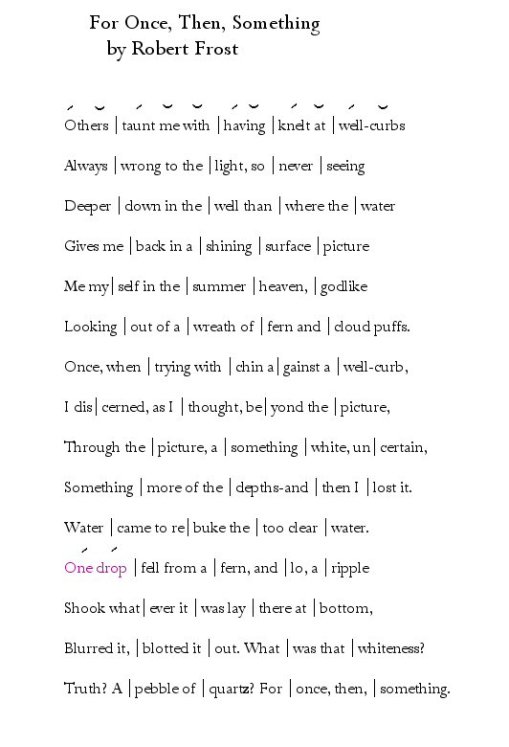


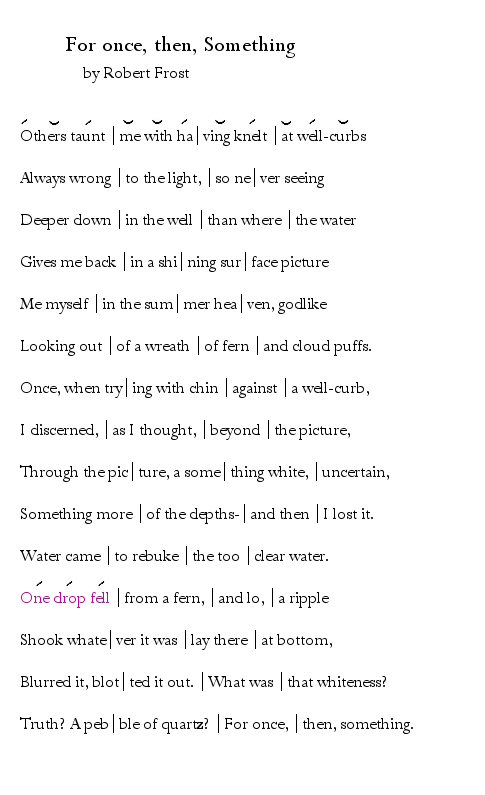












 that his beautiful language and careful phrasing triumphs over his monotonous meter – in many cases subtly disrupting it without violating it. It’s a miracle, really. (For an example of a poet who didn’t pull it off, read Spencer’s Fairy Queen.) It was as if the experimentation of the Elizabethans, let alone the Jacobeans, had never occurred. Milton came of age in an exceedingly conservative era- poetically. Meter, in those days, was as dominant then as free verse now, and as unadventurous. Just the fact that Milton wrote blank verse (when everyone else was writing heroic couplets) was an act of defiance.
that his beautiful language and careful phrasing triumphs over his monotonous meter – in many cases subtly disrupting it without violating it. It’s a miracle, really. (For an example of a poet who didn’t pull it off, read Spencer’s Fairy Queen.) It was as if the experimentation of the Elizabethans, let alone the Jacobeans, had never occurred. Milton came of age in an exceedingly conservative era- poetically. Meter, in those days, was as dominant then as free verse now, and as unadventurous. Just the fact that Milton wrote blank verse (when everyone else was writing heroic couplets) was an act of defiance.




 This one is trickier. In modern English, we pronounce attribute as att’ribute when used as a noun and attri’bute when used as a verb. Milton, in a rather Elizabethan twist, is using attributing in its nominal sense, rather than verbal sense. He therefore keeps the nominal pronunciation: att’tributing.
This one is trickier. In modern English, we pronounce attribute as att’ribute when used as a noun and attri’bute when used as a verb. Milton, in a rather Elizabethan twist, is using attributing in its nominal sense, rather than verbal sense. He therefore keeps the nominal pronunciation: att’tributing.


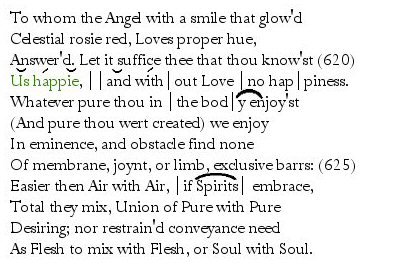
 I’ve looked at several of my books on Frost and none of them extensively analyze the poem. The archetypal meaning of the wall is straightfoward and expounded on by the speaker of the poem. Perhaps the most insightful comment was Richard Poirier’s in Robert Frost: The Work of Knowing. Poirier makes the observation Frost’s “genius as a narrative poet is in part his capacity to sustain debates between people about the nature of the ‘homes’ which they very often occupy together.” Mending Wall is an ideal manifestation of that genius, just as Home Burial is.
I’ve looked at several of my books on Frost and none of them extensively analyze the poem. The archetypal meaning of the wall is straightfoward and expounded on by the speaker of the poem. Perhaps the most insightful comment was Richard Poirier’s in Robert Frost: The Work of Knowing. Poirier makes the observation Frost’s “genius as a narrative poet is in part his capacity to sustain debates between people about the nature of the ‘homes’ which they very often occupy together.” Mending Wall is an ideal manifestation of that genius, just as Home Burial is.

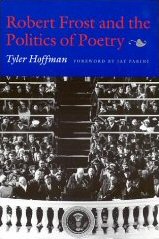







 In either case, the meter disturbingly echoes the slap of his father’s palm on the boy’s head, disrupting the meter of the poem, the waltz, and any joy the boy takes in the father’s drunken attention. The only real anapestic variant in the poem occurs in the second line of the poem’s final stanza – with a palm. Though I shy away from giving poets too much credit for qualities (such as vowel & consonant sounds) inherent in the English language, I think that Roethke’s anapest, in this stanza, was deliberate. He could have written – With palms|cracked hard| by dirt. I think the line would have worked that way. My reading is that the anapest nicely reproduces the hard, swinging whack of the father’s palm on the boy’s head.
In either case, the meter disturbingly echoes the slap of his father’s palm on the boy’s head, disrupting the meter of the poem, the waltz, and any joy the boy takes in the father’s drunken attention. The only real anapestic variant in the poem occurs in the second line of the poem’s final stanza – with a palm. Though I shy away from giving poets too much credit for qualities (such as vowel & consonant sounds) inherent in the English language, I think that Roethke’s anapest, in this stanza, was deliberate. He could have written – With palms|cracked hard| by dirt. I think the line would have worked that way. My reading is that the anapest nicely reproduces the hard, swinging whack of the father’s palm on the boy’s head.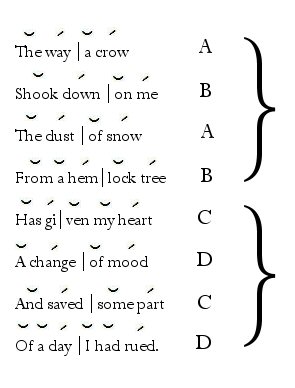
 Iambic: Unstressed syllable followed by a stressed Syllable.
Iambic: Unstressed syllable followed by a stressed Syllable.
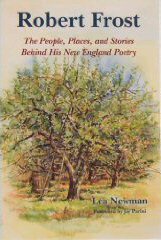
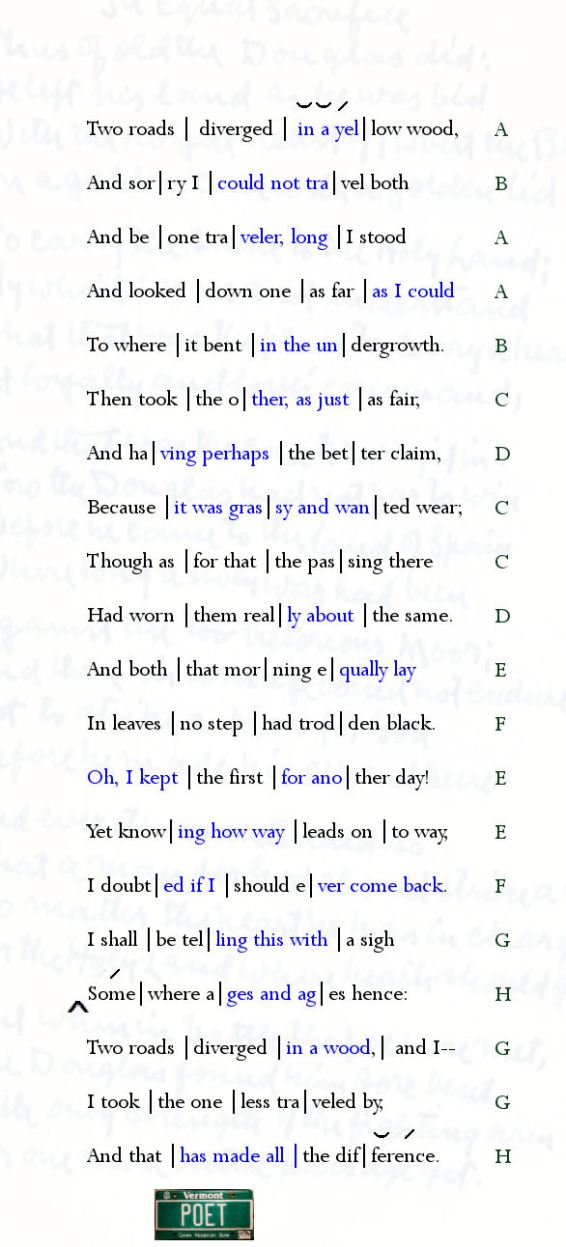
 The first three lines, metrically, are alike. They seem to establish a metrical pattern of two iambic feet, a third anapestic foot, followed by another iambic foot.
The first three lines, metrically, are alike. They seem to establish a metrical pattern of two iambic feet, a third anapestic foot, followed by another iambic foot. This is not an unreasonable way to scan the poem – but it ignores how Frost himself read it. And in that respect, and only in that respect, their scansion is wrong. Furthermore, even without Frost’s authority, their reading ignores Iambic meter. Frost puts the emphasis on trav-eler and so does the meter. Their reading also ignores or fails to observe the potential for elision in trav‘ler which, to be honest, is how most of us pronounce the word. A dactyllic reading is a stretch. I think, at best, one might make an argument for the following:
This is not an unreasonable way to scan the poem – but it ignores how Frost himself read it. And in that respect, and only in that respect, their scansion is wrong. Furthermore, even without Frost’s authority, their reading ignores Iambic meter. Frost puts the emphasis on trav-eler and so does the meter. Their reading also ignores or fails to observe the potential for elision in trav‘ler which, to be honest, is how most of us pronounce the word. A dactyllic reading is a stretch. I think, at best, one might make an argument for the following:

 The second quintain’s line continues the metrical pattern of the first lines but soon veers away. In the second and third line of the quintain, the anapest variant foot occurs in the second foot. The fourth line is one of only three lines that is unambiguously Iambic Tetrameter. Interestingly, this strongly regular line comes immediately after a line containing two anapestic variant feet. One could speculate that after varying the meter with two anapestic feet, Frost wanted to firmly re-establish the basic Iambic Tetrameter pattern from which the overal meter springs and varies.
The second quintain’s line continues the metrical pattern of the first lines but soon veers away. In the second and third line of the quintain, the anapest variant foot occurs in the second foot. The fourth line is one of only three lines that is unambiguously Iambic Tetrameter. Interestingly, this strongly regular line comes immediately after a line containing two anapestic variant feet. One could speculate that after varying the meter with two anapestic feet, Frost wanted to firmly re-establish the basic Iambic Tetrameter pattern from which the overal meter springs and varies.




 This turn hath made amends; thou hast fulfill’d
This turn hath made amends; thou hast fulfill’d























 “You know. . .if I had my way, I’d send that genius son of a bitch an engraved invitation in iambic pentameter: A challenge in two stanzas to meet me alone in the desert. I’ll deliver it. Rommel in his tank and me in mine. We’d stop about paces. We’d get out, we’d shake hands. . . then we’d button up and do battle, just the two of us. That battle would decide the outcome of the war. It’s too bad jousting’s gone out of style.”
“You know. . .if I had my way, I’d send that genius son of a bitch an engraved invitation in iambic pentameter: A challenge in two stanzas to meet me alone in the desert. I’ll deliver it. Rommel in his tank and me in mine. We’d stop about paces. We’d get out, we’d shake hands. . . then we’d button up and do battle, just the two of us. That battle would decide the outcome of the war. It’s too bad jousting’s gone out of style.”